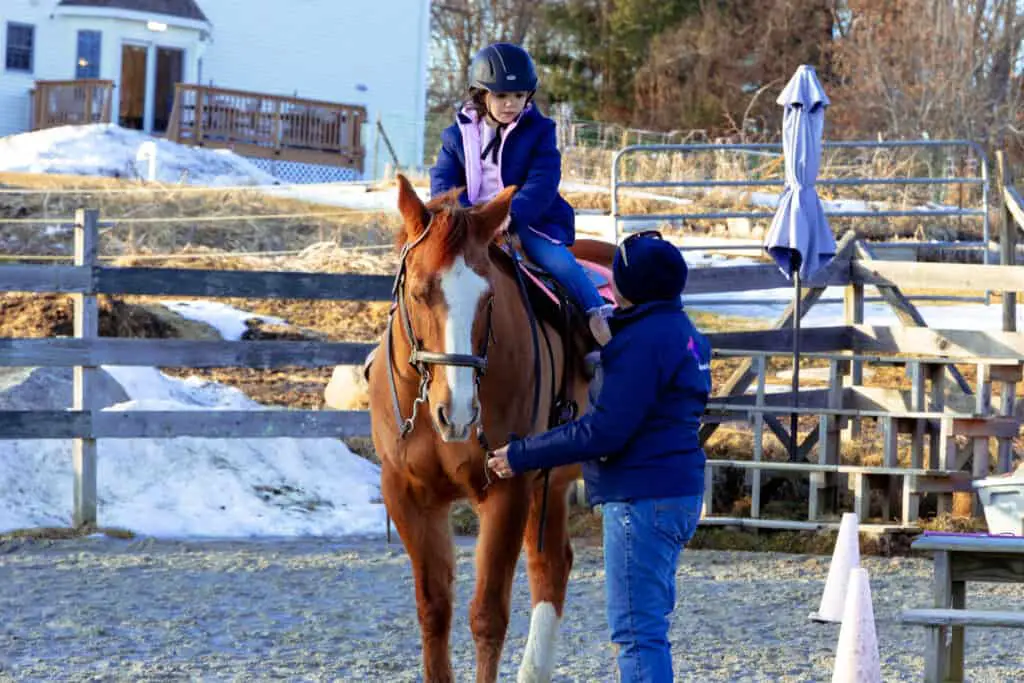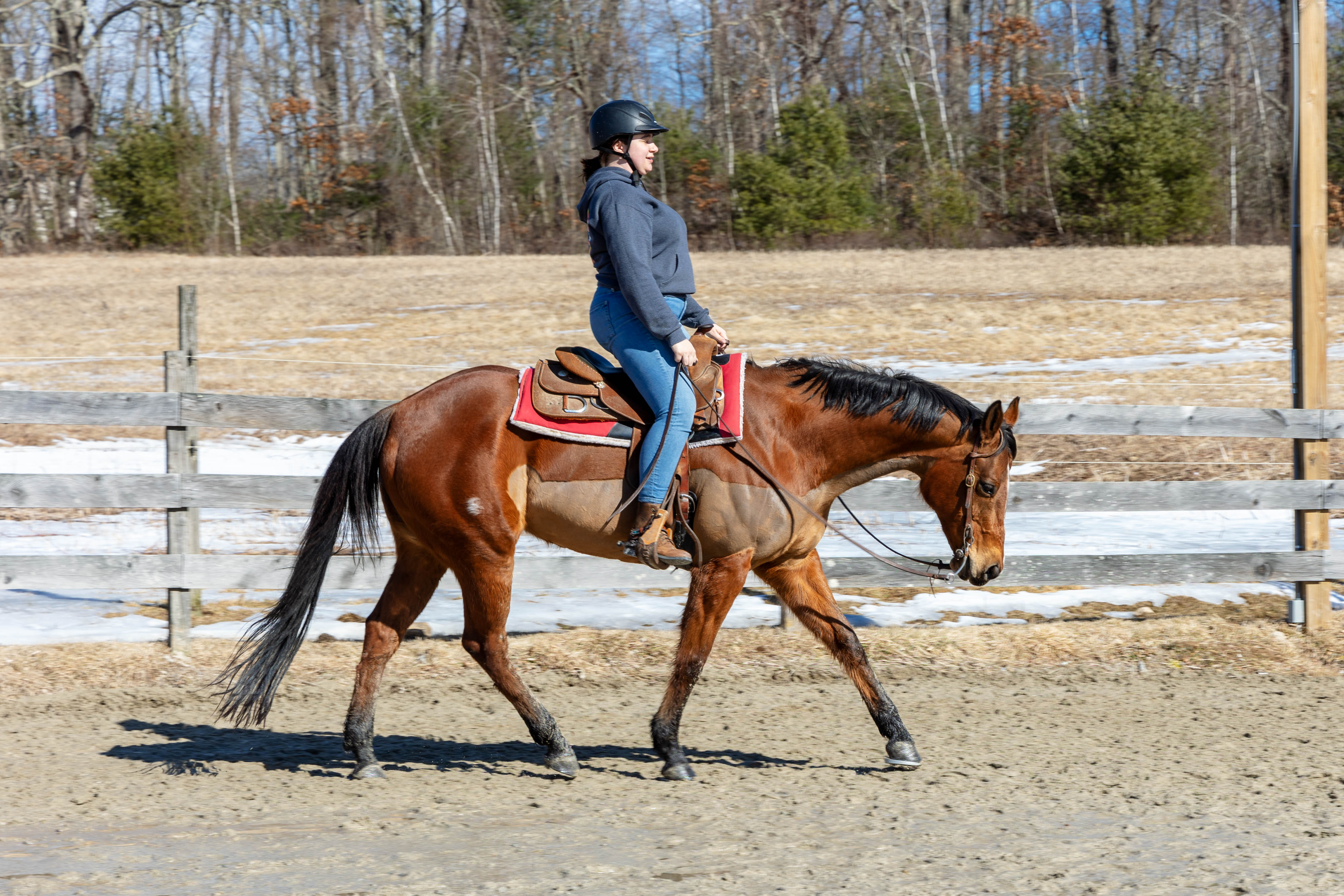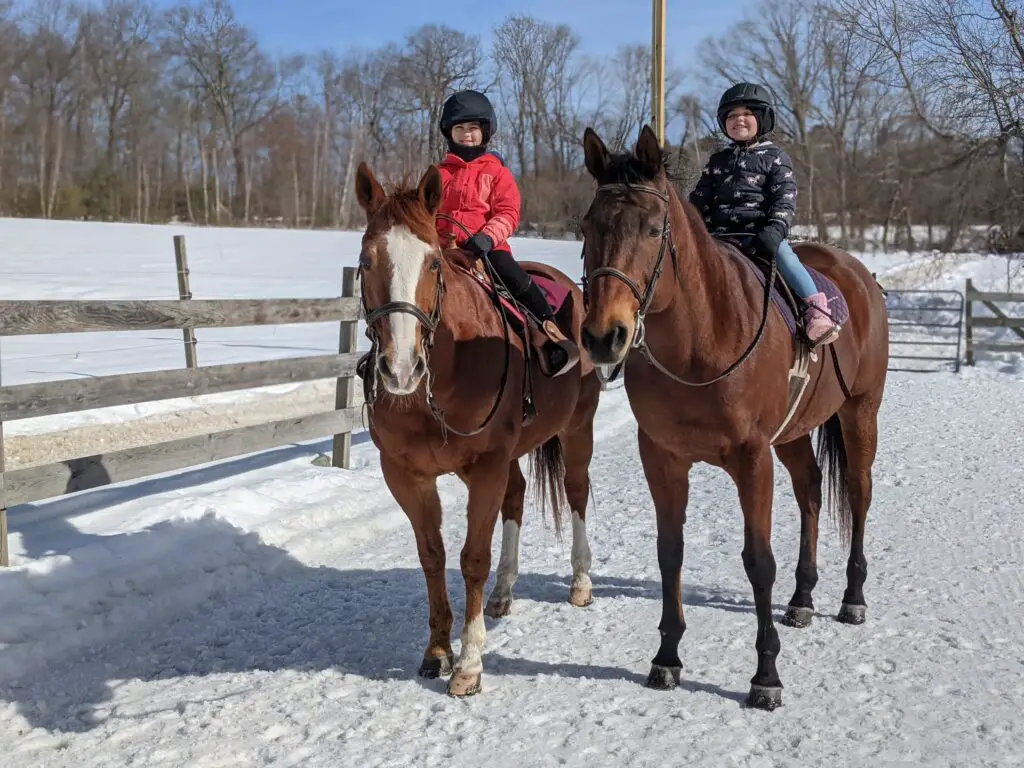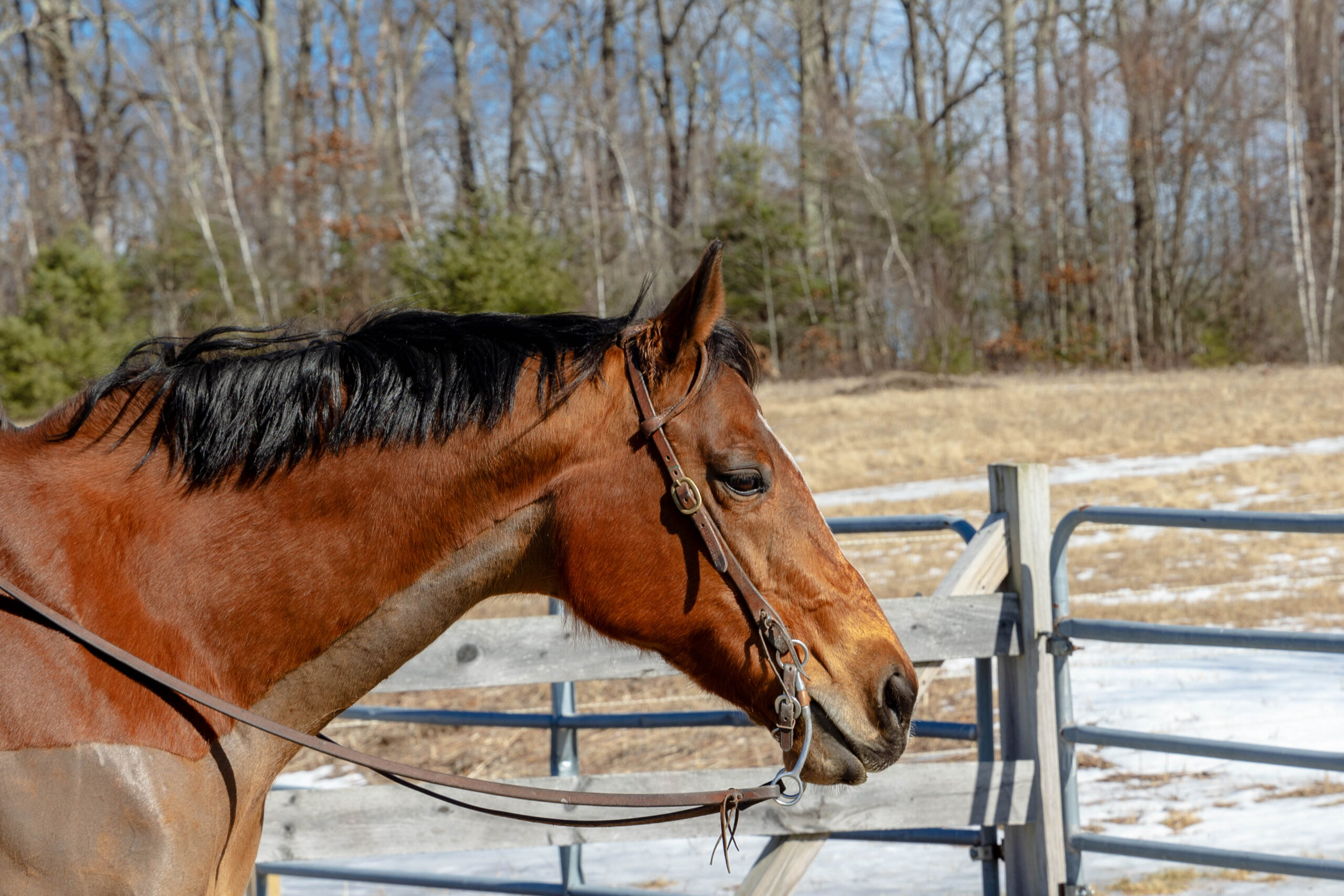As a novice equestrian you’re bound to make some mistakes around horses. The fact is, it’s inevitable because unless you’ve spent time in the barn there some things that may not be obvious. In this list of 20 common mistakes beginner equestrians make we’ll review what not to do in the barn and why. You’ll have a better understanding of why certain actions could be dangerous and how to avoid putting yourself in harm’s way.
This post may contain affiliate links which means that I may earn a small commission at no extra cost to you. As an Amazon Associate I earn from qualifying purchases.
1. Improper Footwear
I’m not going to get all preachy with this one because I’ve mentioned it in a few other articles. You can check them out here if you’re interested in barn safety tips or attire for your first riding lesson. But, it is super important nonetheless. Horses are heavy, and they can’t see their feet!
If you get stepped on by accident (which is more common than you would think) it hurts! I’ve been stepped on many times and with boots on as much as it hurts luckily there was no damage to my foot. However, I’ve been stepped on wearing sneakers too. I won’t describe my injuries in order to avoid turning anyone’s stomach. But, let’s just say it wasn’t pretty and I was in a lot of pain for weeks.
Just wear boots in the barn!
2. Not Wearing A Helmet
Ok, I’ll admit. At times, I’m guilty. I don’t always wear a helmet and I wear my western hat when I show in western classes. But, I accept responsibility for anything that happens to me and I’ve been riding for most of my life. Not that this is a good excuse for not wearing a helmet, it isn’t! But, I don’t want to be a hypocrite so I’m owning up.
If you are a beginner rider, you don’t know what you don’t know.
You don’t understand horses and their body language, you cannot anticipate accidents. You don’t have balance, coordination or the timing to gain control of a situation quickly. Even experienced riders sometimes lack these skills in the moment when something unexpected happens.
Plus, if you’re a beginner, you’ve likely never been hurt by a horse before so you don’t realize the gravity of dangerous situations.
If you’re a professional or very experienced rider, you should still wear your helmet. If you don’t, I won’t judge.
However, I am a firm believer that all beginners should wear a helmet no matter what! Don’t worry about being cool, helmets can save your life!
If you’re looking for a helmet recommendation, check out this review I wrote about my new helmet. I’ve also linked (affiliate links) a couple of helmets I’ve used and recommend here in case you want to check them out.
3. Embellishing Experience Level Or Overconfidence
Once again, I’ll admit I’m guilty. As a child with a couple of years of experience I liked to think I knew what I was doing. I wanted to ride bigger, fancier harder horses.
And during my many years in barns, in lessons and at one point teaching lessons I’ve encountered this many times. Ok, more than many. Like almost every new student that had ever been on a horse ever.
Even if you’ve been riding for a while, don’t over exaggerate your ability when talking with a prospective instructor, looking at horses to buy or chatting with your friends. Any good horseman can see right through it before you even get on. And, when they do get a chance to see you ride they will assess your ability quickly.
It’s important to be matched with a horse that suits your ability level. If you are just very ambitious, be honest about that. You can say, “I’m a beginner but I love horses and have a goal of becoming a professional trainer.” Or, insert your own goal whether it be showing and winning, buying your own horse, trail riding confidently, etc.
Being dishonest or overconfident can and will lead to you getting hurt.
4. Ignoring The Riding Instructor
There are two reasons a student may ignore instructions from their horseback riding instructor or trainer.
The first is, they think they know better which is rarely true but not unheard of. Don’t assume you know better than your trainer. They are a professional trainer for a reason. If you cannot confidently trust them and follow their advice, it’s time for a new trainer. If you respect them, listen to them. They’re trying to keep you safe and help you be successful!
The second reason is, fear. Complete paralysis by fear and the inability to snap out of it. If you tend to freeze up and are unable to follow instructions when you get nervous try practicing before you get on a horse. When you’re at home or in the barn and not riding, take some deep breaths. Picture the situation you’re nervous about, practicing staying calm and reminding yourself to listen to your instructor. Let your instructor know how you’re feeling ahead of time so they can be ready to assist you.

5. Not Asking For Help
Humility is the key to success when it comes to horses. Don’t be ashamed to ask for help even if you’re struggling with a task you’ve done a million times. Can’t remember which way to put your girth on? Can’t get the horse to cooperate and pick up his hooves? Feeling unbalanced and insecure during your lesson? Don’t remember which way to put on your horse’s leg wraps or boots?
Just ask! There’s no shame in asking for help. Your instructor would much prefer to help you or show you something again than put you or the horse’s safety at risk.
In addition to your safety being a primary concern, the horse’s well being is of the utmost importance to your trainer. Not only do trainers love their horses (it’s probably why they became a trainer), horses are expensive! Hurt horses are expensive! Sick horses are expensive! Just ask for help!
6. Riding With Your Heels Up
If you’ve taken even one horseback riding lesson, you’ve probably heard the phrase heels down. And, get used to it because you’ll hear it over and over throughout your riding career whether it’s to you or someone else in the ring. At home, at a show or on a trail ride, you will hear heels down many times.
Often times beginner riders ride with their toe pointing down and heel pointing up. This is poor practice for a few reasons. Keeping your heels down in the stirrup will help you to balance and stay centered in the saddle as well as absorbing the horse’s motion. It will also prevent your foot from falling out of the stirrup and causing you to lose your balance.
Riders who keep their heels up may also be inadvertently squeezing the horse’s sides causing them to go faster or turn. And lastly, your foot could slide through the stirrup and get caught. Keep the stirrup on the ball of your foot and your heel down during your ride. But, try not to force it by pushing on the stirrups too hard and pushing your leg out in front of you.
7. Feet Too Far Into The Stirrups
If you’re feeling insecure during your first few rides you may be tempted to push your foot further into the stirrup. Or, you may lack the body control to keep your foot in the proper position. As I mentioned above, it’s important to keep the ball of your foot on the stirrup.
Pushing your feet too far into the stirrups is dangerous. If you were to fall off your foot could get caught and you could get dragged by the horse. This is another reason why the proper footwear is so important. A boot with a small heel will stop your foot from sliding through the stirrup if you have trouble keeping the stirrup positioned correctly.
8. Open Hands On Reins
It’s important to close your fingers around the reins correctly for a couple of reasons. First, you don’t want the reins to slide through your hands. If the horse were to pull you could lose one of your reins which would prevent you from stopping and steering the horse.
Second, I’ll just be blunt. Open fingers could equal broken fingers! If you ride with your fingers open and lose your balance and fall forward onto the horse’s neck you will jam your finger. You may even break it. Keep your fingers closed on the reins for safety!
9. Gripping and Pulling Reins Excessively
While it is important to keep your hands closed around the reins, you don’t need to have a death grip. Often times novice riders grip the reins for dear life and pull on the horse’s mouth. When you pull on the reins for balance or out of fear, you are pulling on the metal bit inside the horse’s mouth.
The horse cannot move forward freely when asked if you are holding the reins back. And, if you pull hard enough you can actually hurt the horse. Your instructor will show you how tight or loose to keep the reins depending on the horse you are riding. Once they adjust your reins, close your fingers and relax your arms. Then, try to keep your hands in the right place and avoid excessive pulling and yanking. You may not even realize you’re pulling too hard unless your instructor tells you.
10. Hands High Up In The Air
Another common mistake for beginner horseback riders is pulling the reins up too high in the air. If your hands are up in the air near your helmet, chances are your reins are too long. If you run out of space to pull back towards your body, your reins are too long.
Sometimes riders lift their hands due to lack of balance as well. Try to be mindful of where your hands are moving and keep them low and your arms relaxed.
11. Crossing Reins Over The Horse’s Neck
In addition to riding with reins too high, often times beginner riders cross the reins over the horse’s neck in an effort to steer. Your reins are not like the steering wheel of your car. In order to turn one way or the other, beginner riders should use an opening rein which means pulling the rein outward away from the horse’s neck.
If you pull both reins to one direction the horse will likely just stop because they feel pressure from both reins pulling back on the bit. This tends to frustrate beginner equestrians. Pulling one rein across the horse’s neck to get them to turn is also counter intuitive.
If you pull the left rein to the right because you want the horse to go right, you’re still pulling their nose to the left which means they can’t turn right. Even if you ride western and your horse neck reins, you should not cross the rein and pull. A horse that neck reins responds to a rein laying against their neck, not pulling the opposite side of the bit.
12. Looking At The Horse Instead Of Where You’re Going
Riding horses may be a brand new experience for you. And, with that comes lots of excitement and enthusiasm. So, it may be difficult to stop watching what the horse is doing. In fact, even for those of us who are not beginners, it’s hard to take our eyes off the horse.
Try to remember to look where you want the horse to go instead of where the horse is going or at the horse. It’s important to keep your eyes up so you can be aware of your surroundings and the other horses riding in the arena.
If you’re looking at the horse you cannot steer and you can’t see a possible spook coming. This is how accidents happen. So, just like you’ll hear “heels down” on repeat you will likely also hear “eyes up” just as often in your lessons.

13. Slouching, Leaning Forwards And Riding In The Fetal Position
When you’re riding try your best to sit up straight on the horse. Leaning forwards is dangerous and could cause you to fall. If you get nervous take a deep breath and communicate with your instructor instead of curling into the fetal position. You may be having a hard time envisioning this and thinking it’s difficult to get in the fetal position while on a horse. But, it happens and frequently. Riders who get nervous tend to curl up and pull the reins.
Keeping your back straight, with your shoulder, hip and heel aligned will give you the maximum amount of balance, stability and security in the saddle.
14. Leaning Too Far Back
Many beginner riders lean too far back when they are trying to stay balanced and sit up straight. However, this will cause the rider to be behind the motion and could actually send the horse forward meaning they will go faster.
Try your best to stay centered in the middle of the saddle and keep your heels down to avoid this. As a beginner rider your instructor will likely help you position your hands, legs, feet and shoulders several times over the course of the first few months. Being ahead of or behind the horse’s motion is common as you learn to balance but over time you will be able to stay in the middle.
15. Holding Your Breath
Horses can be intimidating if you haven’t ridden much or handled them on the ground. They can be quite large and even the walk can make a new rider feel very unstable. You might feel like you’re going to tip and slide right off the horse causing you to become nervous.
Holding your breath is a common reaction to nerves but it won’t help you stay on the horse. Horse’s can feel your tension and even subtle changes can affect the way they respond to the rider.
16. Gripping Your Legs
In an attempt to balance you might be tempted to hold onto the horse with your legs. This is a no no. Holding on with your legs will irritate the horse or cause them to go faster. If your horse has a spur stop, squeezing your legs will cause them to stop.
It’s better to try to keep your legs relaxed and only squeeze or apply pressure to the horse when you are cueing the horse to do something. If you don’t have a reason to pull, squeeze or kick then you should try to sit still and stay relaxed.
17. Scrunching Up Your Knees
Scrunching up your knees goes hand in hand with gripping your legs for balance. Insecure riders sometimes pinch their knees against the horse for balance and scrunch their legs up. Keeping your legs long and relaxed and using your calf and heel to cue the horse is important. Try not to hold on with your legs for balance and remember to use your seat and heels for balance instead.
18. Riding With Your Elbows Out A.K.A Chicken Wings
Another common flaw most beginner riders do is riding with their elbows poking out! This is a problem because it prevents the rider from keeping the proper rein contact. The most effective way to ride and communicate with your horse is to keep a straight line from the bit to your elbow. If you break at the wrist or pop your elbows out like chicken wings, the contact will be broken.
When the contact is broken it’s difficult to steer and stop the horse correctly. Your cues will be less effective and you could also lose your balance! So keep your elbows in close to your sides. An easy way to do this is to hold the reins with your thumbs on top and pointing the direction you want to go. You can remember this by pointing your thumbs where you want to go and your elbows where you came from.
19. Allowing The Horse To Go Wherever He Wants
Failing to give the horse clear direction means the horse can choose to do whatever he wants. Some savvy lesson horses will simply do what they’re supposed to do because they have the ability to ride on auto pilot.
Sometimes this can lead to the horse trying to nibble on grass around the edge of the arena or just wandering aimlessly. This is dangerous because if your horse isn’t focused on the rider there is more opportunity for them to spook, trip, get too close to other horses etc.
Even the most novice riders need to be focused on what the horse is doing and give them guidance. It’s important to build a relationship with the horse and teach them to trust you. Allowing a horse to make their own choices during a ride can result in an injury. It’s important to cue the horse correctly as well, so listen closely to your instructor’s directions.

20. Frustration At The Horse
Frustration is imminent if you plan to spend time around horses or riding. However, often times beginner riders give cues to the horse incorrectly which means the horse does not do what the rider wants. Instead, the horse will do what the rider asked them to do instead of what they intended. Or, they may simply ignore the rider because they are confused.
Confusion is usually the reason a horse will not listen to the rider especially when it comes to beginners. One of the biggest mistakes beginner equestrians make is blaming the horse and becoming frustrated. Try to think clearly about what you are asking the horse to do and if you asked correctly. Ask for help and try again.
No rider, regardless of skill level should take their frustration out on the horse or blame the horse if a ride isn’t going well. There are times that horses can be disobedient and uncooperative. However, generally speaking, if you want your horse to perform better, you have to ride better.
I hope you found this article helpful! If you did, please give it a share!

